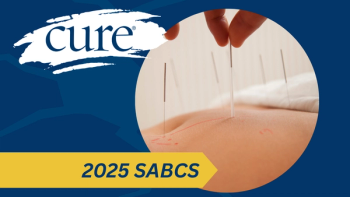
New Agent Shows Promise Across Many Cancers Which Have TRK Fusion Mutations
Promising results from a new agent may set the stage for a new standard of care for patients with TRK fusion mutations.
Larotrectinib, a novel pan-TRK inhibitor, produced response in about 75 percent of patients with a range of TRK fusion—positive solid tumors, potentially laying the groundwork for the oral agent to become standard of care for both adults and children with any advanced tumor that harbors this mutation.
“You would be hard-pressed to find a targeted therapy even within a single disease context that has results like this,” said David Hyman, M.D., chief of early drug development at Memorial Sloan Kettering Cancer Center, who reported the findings during a press conference June 3 at the 2017 ASCO Annual Meeting.
Twelve percent of patients in the study had a complete response and 64 percent a partial response; of the latter, Hyman reported, “most were not just meeting criteria for partial response, but had very deep tumor regressions.”
Larotrectinib is currently the only selective pan-TRK inhibitor in clinical development, Hyman said. He added that the oral agent may become the first to be used in a truly tumor-agnostic manner, and that, “To our knowledge, it may be the first cancer therapy ever developed simultaneously in both adults and children.”
TRK fusions occur when one of the TRK genes becomes abnormally connected to another gene. This fusion event causes the TRK gene to be turned on and the cancer to grow. It’s estimated that, annually, up to 5,000 patients harbor TRK fusion mutations, but Hyman stressed that “this number may significantly underestimate its prevalence due to inadequate ascertainment by many of the existing profiling technologies.”
ASCO reported that TRK fusions were first discovered in colon cancer in 1982, but only recently has next-generation sequencing enabled them to be systematically detected. To date, more than 50 different partner genes that fuse with one of threeTRK genes (NTRK 1, 2, and 3) have been identified.
Hyman explained that TRK fusions typically follow two patterns: In adults, they occur rarely in more common cancers, such as brain, lung, colon, pancreatic, sarcoma and melanoma; or, they occur more frequently in rare cancers, such as salivary and secretory breast cancer. This pattern also prevails in the pediatric setting, where the mutation is rarely seen in glioma and sarcoma, but more frequently in infantile fibrosarcoma and congenital nephroma, for example.
Although relatively rare, Hyman said that it is hard to find a tumor type where TRK fusions have not been reported. “One of the defining features of TRK fusions is that they are not just found in one cancer type, but can be found in dozens of different cancer types—and in both children and adults.”
The study he reported at ASCO involved 55 TRK fusion—positive adult and pediatric patients with advanced solid tumors representing 17 unique cancer types, who were enrolled in one of three clinical phase 1/2 clinical trials. Hyman emphasized that the patients were identified on the basis of local testing, and thus provide an example of “real world” experience: “We did not perform central screening to find the TRK fusions; in fact, 15 different laboratories identified the 55 patients who are described in this study.”
Hyman reported overall response rates (ORR) based on investigator assessment for 50 patients for whom confirmatory response data were available; larotrectinib (100 mg) was taken twice daily. The ORR was 76 percent (95 percent CI, 62 percent-87 percent), and this includes a partial response in 64 percent of patients and a complete response in 12 percent. Five additional patients, who joined the study too early to have had their confirmatory scans, all had at least a partial response to larotrectinib, Hyman noted.
Among the patients with a partial response to larotrectinib, Hyman said that two had such deep tumor regressions that they were actually able to be downstaged and taken forward to potentially curative surgery with pathologic complete responses.
No trend toward better results was seen with larotrectinib in one tumor type versus another. Responses occurred a median of 1.8 months into therapy, which Hyman explained was actually just a reflection of when the patients had their first scan: “In the clinic, patients reported dramatic improvement in their symptoms within days of beginning therapy.”
Larotrectinib is notable not only for its tumor- and age-agnostic paradigm, but also for its favorable toxicity profile, said Hyman. The most common side effects were fatigue and mild dizziness.
“This is an extremely well-tolerated therapy, with only 13 percent of patients requiring any form of dose modification and not a single patient discontinuing due to adverse events,” he said.
In concluding his presentation, Hyman noted that 93 percent of responding patients and 75 percent of all patients have remained on therapy or undergone surgery with curative intent. “I believe these data support larotrectinib as a new standard of care for these patients,” he said. However, for its potential to be fully realized, this will require that patients be tested more universally for the presence of this mutation, as well as for other tumor-agnostic biomarkers such as microsatellite instability. “To really enjoy these benefits,” Hyman said, “we’ll have to change the paradigm by which we test these patients.”
Larotrectinib is being developed by Loxo Oncology, Inc. Hyman reported that the company anticipates submitting a new drug application for the novel agent in late 2017 or early 2018.




